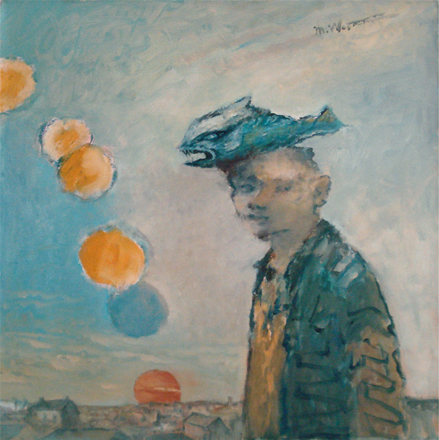Maverick Maine Painters on the Web
Over the years I’ve been fortunate enough to spend time with a great many artists, from the famous — Neil Welliver, Andrew Wyeth, Alex Katz, Robert Indiana — to the obscure. On the whole, I prefer the obscure — painters who persist whether or not they ever achieve critical acclaim or commercial success. Why? Because […]

Boy With a Fish on His Head by Michael Waterman
Over the years I’ve been fortunate enough to spend time with a great many artists, from the famous — Neil Welliver, Andrew Wyeth, Alex Katz, Robert Indiana — to the obscure. On the whole, I prefer the obscure — painters who persist whether or not they ever achieve critical acclaim or commercial success. Why? Because their art is inseparable from their beings.
Museum exhibitions, gallery shows, patrons, and prizes have been the coins of the realm in the art world forever, but the advent of the digital age has given any artist who can afford a Web site a way for his/her work to reach the world. Three of my favorite Maine painters are online all the time.
What the late, great Carlo Pittore, the maverick Matt Donahue, and the mysterious Michael Waterman have in common are an uncompromising individualism and an eccentric authenticity beyond fashion and the marketplace. I call your virtual attention to them here simply because they’re exactly what you want artists to be — free and independent souls.
Carlo Pittore (1943-2005) was born Charles Stanley but became Carlo Pittore (Charles the Painter) while living in Italy in the 1960s. Carlo was the very soul of an artist, a man fierce in defense of artistic expression, which in his case meant figurative art. He painted human flesh like no other artist I know, but what he was always after was the human soul.
For many years Carlo lived in a yurt in the woods of Bowdoinham, Maine, in later life living, painting, and teaching in a studio apartment in a former chicken-processing barn. Shortly before his death in 2005, Carlo and some of his many friends established the Carlo Pittore Foundation for the Figurative Arts, which now maintains a Web site of the same name.
The Carlo Pittore Web site doesn’t yet feature many of Carlo’s meaty nudes and raw portraits, but it does include some of the postal works for which he was famous in the small world of mail art, as well as links to a great deal of information about his art.
I’ve known Matt Donahue since he was known as Magic Matt, the most prolific scorer in Westbrook (Maine) High School and University of Southern Maine basketball history. Matt always had two great loves, which he continues to pursue: basketball and painting. In high school, he specialized in portraits of sports heroes (something he still does on occasion to earn a little money), but I tend to think of Matt as the Picasso of the suburbs. His little studio above a garage in South Portland is jammed full of wildly imaginative and extremely colorful figurative abstractions that owe an obvious aesthetic debt to the greatest painter of the modern age, while somehow managing to remain pure Matt Donahue.
Many of Matt’s paintings have religious themes (I own a wonderful painting of the Holy Family), but they run the emotional gamut from celebration to lamentation. There are people who own dozens of Donahues; some now own nothing but. As Matt’s work exists on its own outside the established art scene, you can see it only at his studio, at J.P. Thornton’s cafe in South Portland, and online.
Michael Waterman is a Ryder-esque figure whose lightly surreal work conjures the spirit of his native city of Portland, Maine, better than anyone who paints it more precisely. Waterman paints the essence of a magical place by the sea where a boy may walk around with a fish on his head, a woman may use the cityscape as an umbrella, or the earth itself may wash up on the shores of Portland Harbor. Michael does show locally at the Aucocisco Gallery but his melancholy and strangely beautiful paintings may also be seen at www.mwaterman.com.
When I think of Carlo, Matt, and Michael, I think of Gulley Jimson, the hero of Joyce Cary’s The Horse’s Mouth and the finest fictional painter in literary history. It was the immortal Gulley Jimson who said, “Go love without the help of anything on earth; and that’s real horse meat. A man is more independent that way, when he doesn’t expect anything for himself.”
Edgar Allen Beem
Take a look at art in New England with Edgar Allen Beem. He’s been art critic for the Portland Independent, art critic and feature writer for Maine Times, and now is a freelance writer for Yankee, Down East, Boston Globe Magazine, The Forecaster, and Photo District News. He’s the author of Maine Art Now (1990) and Maine: The Spirit of America (2000).
More by Edgar Allen Beem

